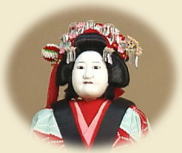Kugutsu-mawashi
From ancient times, people believed that
dolls could take the place of human beings.
Dolls were also considered incarnations of
gods and so were a part of folk religion.
Eventually, bands of performers started to
travel the country, visiting shrines and
temples and villages, and performed with
their puppets. These performers were called
kugutsu-mawashi. |
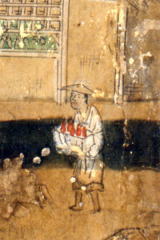
Images of kugutsu-mawashi
from a collection of National Museum
of Japanese History
|
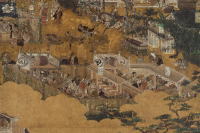 |
The Birth of Ningyo joruri
In the Edo period, puppet theater,
which
was all the craze throughout
the country,
and joruri, which provided dramatic
narration
with music, came together naturally.
In this
way, "ningyo joruri"--puppet
theater
with narration and music--was
born. Against
the backdrop of rapid urban economic
development,
ningyo joruri became one of the
most popular
forms of entertainment for the
masses.
|
Takemoto Gidayu
At the end of the 17th century, a joruri
narrator named Takemoto Gidayu appeared in
Osaka and created "Gidayu bushi,"
a form of narration which not only brought
together all the schools of joruri but also
added to this a new sensibility. He then
started his own theater company, Takemoto-za,
in Dotonbori for performing puppet plays
which became the most popular venue for entertainment
in that city. |
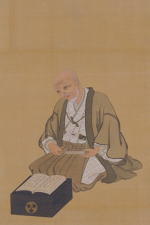
Portrait of Takemoto Gidayu
from the collection of
the Osaka City Museum
|
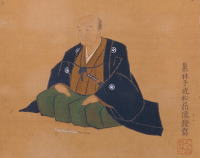
Portrait of Chikamatsu Monzaemon
from the collection of the Osaka
City Museum
|
Chikamatsu Monzaemon
Though born of a samurai family, Chikamatsu
Monzaemon discarded his birthright as a samurai
and went to Kyoto to be a writer after his
father became masterless. In his thirties,
Chikamatsu wrote joruri plays. In his forties,
he wrote Kabuki plays for the popular actor
six years his senior, Tojuro Sakata. |
The Collaboration between Gidayu and Chikamatsu
When Takemoto Gidayu started to collaborate
with Monzaemon Chikamatsu, two years his
junior, a new partnership between narrator
and writer began. Chikamatsu resumed writing
joruri plays which offered more freedom compared
to restrictive Kabuki plays, and went on
to produce many ningyo joruri scripts exclusively
for the Takemoto-za. |
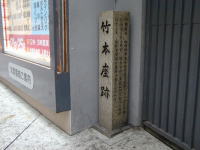
Present-day Dotonbori. Tablet
in from of Naniwaza Theater
marking the spot where
Takemoto-za used to be
|
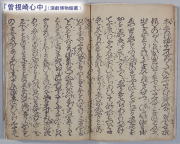
Script of Sonezaki Shinju
|
The Collaboration between Gidayu and Chikamatsu-
"Sonezaki Shinju" ("Love
Suicides
at Sonezaki")
Chikamatsu Monzaemon developed a new genre
of drama through his work in ningyo joruri.
It was called "sewamono," and represented
the lives of the city folk around him. His
play "Sonezaki Shinju" ("Love
Suicides at Sonezaki") which dramatizes
a double suicide incident from 1703 became
immensely popular. |
"Sonezaki Shinju" ("Love Suicides
at Sonezaki")
After his friend Kubeiji swindles
money from
him, Tokubei, an employee of
a soy sauce
store is despairing of any kind
of future
with his lover, the prostitute
O-Hatsu. Because
they can not be together in this
life, this
young couple put their faith
in the next
life and commit suicide together.
This photograph
is from the "Tenmanya"
scene of
the play where they try to affirm
their decision
without others noticing.
|
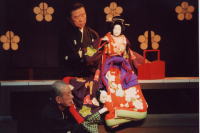
O-Hatsu doll and performers |
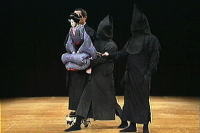 |
When Chikamatsu Monzaemon and
Takemoto Gidayu
established the foundations of
joruri, the
puppets used in the plays were
still each
manipulated by a single puppeteer.
However,
soon thereafter, the form evolved
to require
three puppeteers per puppet who
worked to
find and perfect ways to make
the puppets
mimic human movement.
|
Chikamatsu Monzaemon wrote many pieces for
Bunraku and Kabuki. He is often compared
to William Shakespeare.
In my town Karatsu, there is a temple named
Kinshoji, where Chikamatsu Monzaemon spent
some years of his young studying days.
|

Chikamatsu's another famous "Sewamono",
"Meido no Hikyaku"
|
